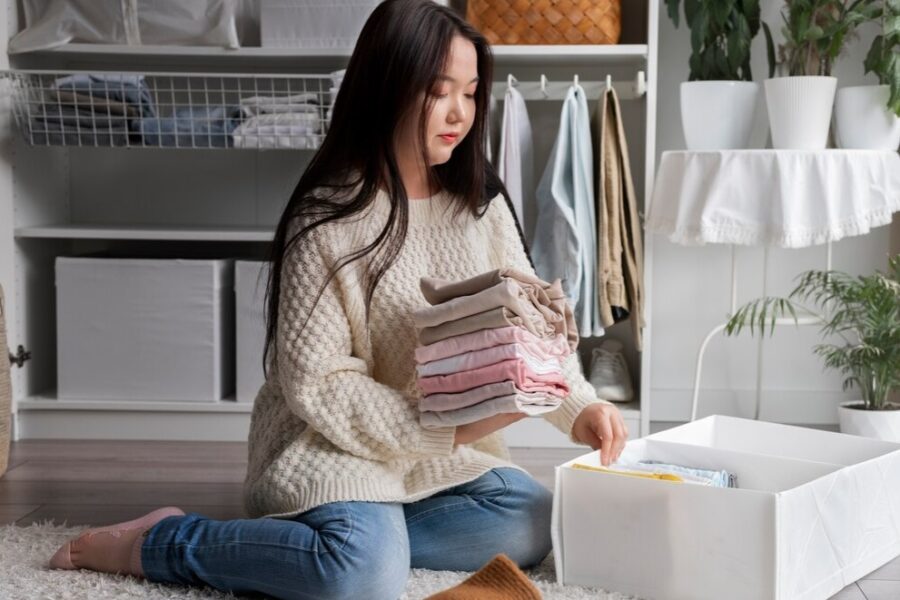


Are you thinking about making your wardrobe more sustainable and ethical? When all you hear is how fast fashion is destroying the environment. We all want to live more sustainably, but changing our clothes may be intimidating. When there is so much to be done, where do you begin?
You may take immediate action right now to build a green and ethical wardrobe.
Let me calm your worries by saying that dressing sustainably is economical and gives you access to all the clothing options you desire. So why not start creating your ethical and sustainable wardrobe right now?
What is a sustainable wardrobe?
A sustainable wardrobe minimizes the environmental impact that your clothing has.
You will have made significant steps toward creating your sustainable wardrobe if you invest in high-quality, timeless clothing, take good care of what you currently have, and wear most of your wardrobe rather than just 20% of it. Really, it doesn't need to be much more challenging than that.
A sustainable wardrobe is cherished, worn, and used repeatedly. It is something you can be proud of and works for every situation. There are easy actions you can start doing right away to create a wardrobe that is genuinely ethical and sustainable. Now let's focus on what you can do right now to start dressing sustainably.
1. Buy quality clothes that last
The phrase "buy nice or buy twice" is one that we have all heard. For fashion, this statement is undoubtedly valid. The cost of high-quality goods can be deterring, particularly for someone just beginning their quest to assemble their first eco-friendly wardrobe.
It's natural to want to contrast a product with what you would buy at your preferred high street shop, where it would cost half as much. However, likely, the less expensive option will only last for a while.
Keeping this in mind will make buying a slightly more expensive item easier. It will seem much more valuable if you are confident in your ability to continue loving it.
2. Look at the label
Many fast fashion businesses are embracing the concept as sustainable fashion gains popularity. But not all sustainable clothing companies are created equal.
So how do you select eco-friendly clothing? Checking the label is a fantastic place to start. If a product contains a name you can't pronounce, it probably includes petrochemicals (such as Polyurethane). Want more proof? On a brand's website, whether sustainability is, a significant focus or just a trend-following afterthought is evident.
I know that it could occasionally be a little confusing. It might almost seem too good to be true that fast fashion powerhouses H&M and ASOS have released sustainable collections.
Don't be duped by sustainable promises, even though these lines assist the industry's journey to a more sustainable future. Why should a sustainable product, like some of the products in Topshop's Considered Collection, include 20% sustainable materials?
3. Find your favourite sustainable and ethical brands
Shopping is simple once you are familiar with your favorite sustainable and ethical clothing brands. However, if you are starting to construct your sustainable wardrobe, you might not be familiar with many eco-friendly labels.
Your preferred brands might support a cause or message that you find compelling. Most importantly, you like their story and admire their sense of flair. You'll quickly recall your favorites.
So where can you buy eco-friendly clothing?
There are hundreds of sustainable clothes brands out there, each unique.
Read more: 12 sustainable fashion brands in India
4. Buy clothes that can be worn through all seasons
Everybody has a wardrobe essential that they wear all year long. This is a simple method for dressing sustainably. You may avoid having stuff gather dust in the back of your closet by purchasing clothing that can be worn at any time of the year.
Spending money on clothing that will function in any condition can make you feel good if you know you'll wear it frequently. We all want to shop more, so you should feel justified spending money on items you know you will use.
5. Wear your wardrobe
Use, love, and wear it all is a terrific idea for creating a sustainable and ethical wardrobe.
Wearing your wardrobe may seem easy, yet we all have clothing at the back of our closets that are never worn. Only 20% of our clothes is actually worn frequently. So instead of going to the high street, consider first looking about your house to see what you can find.
If necessary, look for ideas on how to transform discarded clothing into chic new ensembles. If you truly believe you won't wear it again, simply give it to someone who will...
6. Learn how to repair your own clothes


One of the best things you can do while trying to figure out "how can I dress more sustainably" is to learn how to fix your own clothes. It may seem not easy, but if you understand the fundamentals, it's rather easy.
You can learn how to sew, stitch, and repair worn-out clothing from countless online publications and videos. You will be amazed at what you can do if you put in a few hours. You never know; you might find yourself repurposing those worn-out items you have stashed away in the back of your wardrobe because you enjoy them so much.
7. Care for your clothes so they last longer
Every piece in your wardrobe should be something you take good care of, not simply your new jacket or most costly outfit.
This will ensure that your clothes stay longer and continue to appear as fresh as the day you got them, therefore saving you money. If in doubt, wash your garments on a slower, gentler cycle. Clothing labels frequently include instructions for how to care for them.
Read also: Zero waste bathroom : 13 tips and sustainable swaps
8. Wash your clothes less
Sounds revolting, doesn't it? You'd be shocked at what you can get away with before your clothing begins to smell.
I'm not exempting you from washing socks, underwear, or everyday athletic wear; after all, these items will rapidly begin to smell, and we don't want to be held responsible.
Nevertheless, washing garments less frequently is one of the best strategies to extend their lifespan. This is especially true for bulkier clothing like jumpers, coats, and pants, which require washing considerably less frequently than you may imagine.
Want some inspiration, take Levi’s CEO Chip Bergh as an example, he hasn’t washed his jeans for over 10 years - now that is dedication.
9. Wash clothes on a colder setting
Although we are all aware of it, do we actually do it?
The Energy Saving Trust estimates that washing contributes between 60 and 80 percent of a garment's overall environmental impact. You can save up to 40% on energy by washing your clothes at 30 degrees instead of 40.
Additionally, it is better for the fabric and makes your clothing last longer. Additionally, there is much less of a chance that the colors will fade with time, ensuring that your favorite top will look just as stunning as the day you first got it.


10. Buy Second Hand clothes
The trend of thrift stores has taken off, and for once, the environment is content with this trendy shift to used goods.
The question of whether buying used is sustainable may be on your mind.
One of the most sustainable ways to purchase new clothing is by buying secondhand. This is because already-made clothing is the most environmentally friendly type of clothing you can buy. They may be produced without new resources or energy, making used goods a particularly sustainable solution.





